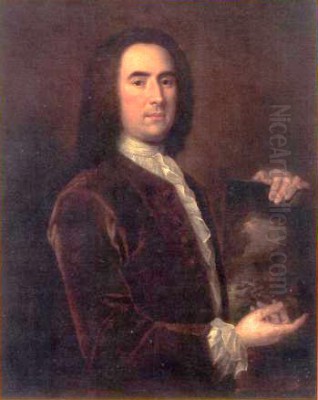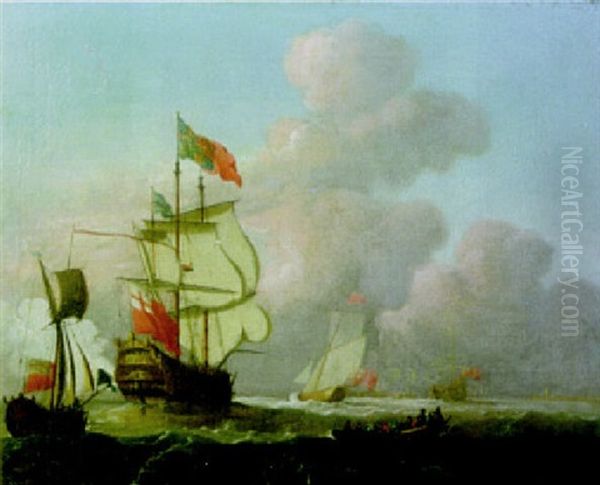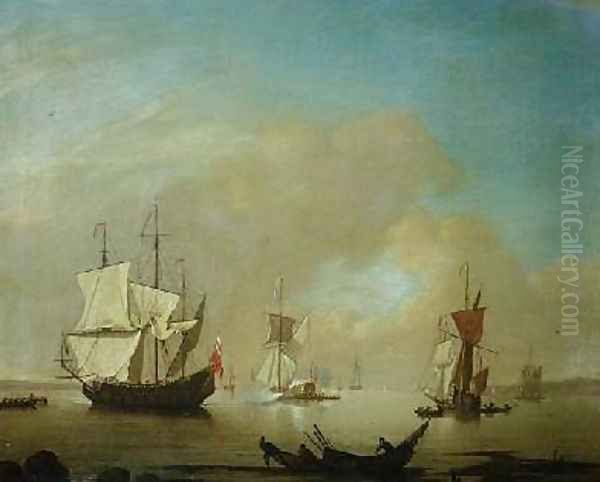
Peter Monamy stands as a significant figure in the annals of British art history, particularly recognized as one of the earliest and most accomplished native-born marine painters in England during the late 17th and early 18th centuries. Born in London, Monamy bridged the gap between the dominant influence of Dutch maritime artists who had settled in England and the burgeoning development of a distinctly British school of marine painting. His work, characterized by meticulous detail and a profound understanding of seafaring subjects, captured the essence of Britain's growing naval power and maritime life.
Early Life and Guernsey Roots
Peter Monamy was baptized in London on January 12, 1681, at the church of St Botolph's-without-Aldgate. He hailed from a family with strong connections to the Channel Island of Guernsey. His parents, Pierre Monamy and Dorothy Gilbert, were both from Guernsey, and his paternal grandfather, André Monamy, had been a notable figure on the island, remembered as a staunch supporter of the Parliamentarian cause during the English Civil War. This heritage likely instilled in the young Monamy an early familiarity with the sea and maritime affairs, themes that would dominate his artistic career.
London, however, was the city where Monamy would build his life and career. The bustling port city, the heart of an expanding empire reliant on sea trade and naval strength, provided the perfect backdrop and market for an artist specializing in marine subjects. His upbringing in this environment, combined with his family's island origins, created a foundation for his later artistic focus.
Apprenticeship and Early Career
Monamy's formal artistic training began around the age of fifteen when he was apprenticed to William Clark. Clark was a member of the Worshipful Company of Painter-Stainers, one of London's ancient livery companies. Importantly, Clark was not primarily an easel painter but operated a business focused on house decoration. This involved tasks such as painting decorative panels, signboards, murals, and other elements of interior and exterior decoration. Monamy's apprenticeship under Clark would have provided him with a solid grounding in the practical application of paints and pigments, decorative composition, and the business side of the art and craft trades.

During his apprenticeship, Monamy would have learned various techniques applicable to decorative painting. This practical foundation, though seemingly distant from fine art marine painting, likely honed his skills in draughtsmanship, colour mixing, and large-scale composition. He completed his apprenticeship around 1704 and subsequently gained the freedom of the Painter-Stainers' Company, allowing him to operate independently. Records show that by 1708, his business was established enough for him to take on his own assistant, Henry Kirby.
Following William Clark's death, Monamy reportedly took over his former master's business. While initially continuing in the vein of decorative work, his passion and talent for depicting ships and the sea gradually led him to specialize in marine easel painting. He established himself near London Bridge, a location strategically close to the Thames River, the Pool of London, and the heart of the city's maritime activity, likely operating shops or a studio there.
The Rise of a Marine Specialist
The early 18th century in England saw a growing demand for marine painting, fueled by national pride in naval victories and the importance of maritime commerce. However, the field had been largely dominated by Dutch artists, particularly the Van de Veldes, who had worked in England. Peter Monamy emerged as one of the first significant English-born painters to dedicate himself almost exclusively to this genre, carving out a niche for himself.
His transition from a decorative painter to a specialist marine artist reflects both his personal inclination and a recognition of the market opportunities. His works began to gain recognition for their accuracy in depicting ships and their skillful rendering of sea and sky. He became known for his portrayals of English warships, merchant vessels, coastal scenes, and naval engagements, capturing the dynamism and atmosphere of the maritime world.
The Enduring Influence of the Van de Veldes
It is impossible to discuss Peter Monamy's art without acknowledging the profound influence of the Dutch marine painters Willem van de Velde the Elder (1611-1693) and, more significantly, his son Willem van de Velde the Younger (1633-1707). The Van de Veldes had moved from the Netherlands to England in 1672/73 under the patronage of King Charles II and James, Duke of York (later King James II). They were granted a studio in the Queen's House at Greenwich and effectively established the benchmark for marine painting in England.

Willem van de Velde the Younger, in particular, was renowned for his exquisite draughtsmanship, his accurate depiction of ships' structures and rigging, and his masterful handling of light, water, and atmospheric effects. Monamy deeply admired and studied the works of the Van de Veldes. It is documented that Monamy owned drawings by the elder Van de Velde, and he undoubtedly had ample opportunity to see their paintings in collections around London.
Monamy absorbed the Dutch masters' techniques, particularly their approach to composition, their detailed rendering of vessels, and their methods for depicting calm and stormy seas. He adopted their typical low horizon lines, which emphasized the vastness of the sky and sea. His work often directly echoes the style and motifs of Van de Velde the Younger, leading some later critics to view him primarily as an imitator. However, while the influence is undeniable, Monamy developed his own distinct, slightly more robust and sometimes more decorative, English interpretation of the Dutch style.
Artistic Style, Techniques, and Themes
Peter Monamy's style is fundamentally rooted in realism and meticulous observation. His primary medium was oil on canvas or panel. He possessed a strong understanding of ship construction, naval architecture, and rigging, which lent authenticity to his depictions. His ships are generally rendered with precision, capturing the specific details of warships, yachts, and merchantmen of the period. This accuracy appealed greatly to patrons connected with the sea, including naval officers and merchants.
His handling of water and sky demonstrates considerable skill. He could effectively portray the different moods of the sea, from calm, reflective surfaces under serene skies to choppy waves and dramatic storm clouds. His depiction of clouds, often rendered with a soft, atmospheric quality, contributes significantly to the overall mood of his paintings. While perhaps not achieving the sheer brilliance and subtlety of Van de Velde the Younger, Monamy's atmospheric effects are convincing and aesthetically pleasing.
Compositionally, Monamy often employed established formulas from the Dutch tradition, arranging vessels in a balanced and harmonious way within the picture plane. His works frequently feature a prominent central ship or group of ships, often set against a backdrop of distant land, castles, or fortifications along the coast. These topographical elements add context and visual interest. Common themes include Royal Navy ships at anchor or under sail, ceremonial salutes, naval reviews, coastal shipping, and occasionally, naval battles or storms. Examples like Sea Battle with Barbary Pirates showcase his ability to handle more dramatic action scenes.
While many of his paintings depict specific types of ships or general maritime activities, they were often intended as decorative pieces rather than strict historical documents of particular events. This decorative quality is evident in their balanced compositions and pleasing aesthetic, making them suitable for display in the homes of the affluent clientele he served. He also utilized printmaking, with engravings being made after his paintings, which helped to disseminate his images to a wider audience.
Representative Works
Several key works exemplify Peter Monamy's style and subject matter. The Royal Sovereign at Anchor, housed in the National Maritime Museum, Greenwich, is a majestic portrayal of the famous first-rate ship of the line. The painting showcases Monamy's skill in rendering the intricate details of the warship and the calm, reflective water surrounding it. It captures the grandeur and power of the Royal Navy's capital ships.
Another notable work is An English Ship with Sails Loosened Firing a Gun, held by The Metropolitan Museum of Art in New York. This painting, once attributed to Van de Velde, was correctly reattributed to Monamy, highlighting the strong stylistic connection. It depicts a common motif: a ship firing a salute, showcasing Monamy's ability to capture the momentary flash and smoke of the cannon fire against a backdrop of meticulously rendered sails and rigging. Variations on this theme, sometimes titled Man-of-war firing a salute or The Morning Gun, appear frequently in his oeuvre.
His painting Naval Vessels escorting the Ship of the Vice-Admiral of the Red demonstrates his capacity for composing scenes with multiple ships, creating a sense of order and naval discipline. The Hermitage Museum in St. Petersburg holds a work titled Ausbruch eines Seesturms (Outbreak of a Sea Storm), indicating his ability to tackle more turbulent and dramatic maritime conditions, a popular theme in marine art. These works, among many others, solidify his reputation for detailed ship portraiture and atmospheric sea conditions.
Career, Patronage, and Recognition
Monamy achieved considerable recognition during his lifetime, becoming arguably the most prominent marine painter in England in the generation following the Van de Veldes. His expertise attracted commissions from those with naval and mercantile interests who desired accurate and evocative depictions of ships and sea life. He is known to have received commissions directly from the Royal Navy and prominent merchants.
Despite his reputation and skill, sources suggest that Monamy was not particularly prosperous. Like many artists of the period, he relied on selling his works through various channels, including commercial picture dealers and galleries. He is also known to have provided paintings for the popular Vauxhall Pleasure Gardens in London, a fashionable public entertainment venue. These large decorative works, displayed outdoors or in pavilions, would have brought his art to a wider public, though sadly, most of these Vauxhall paintings have not survived. The surviving engravings after these works, however, attest to their existence and his involvement with this popular cultural site.
His professional life placed him within the artistic circles of London. He was notably a friend and associate of the celebrated painter and satirist William Hogarth (1697-1764). While the exact nature of their relationship and potential collaborations remains speculative, their friendship indicates Monamy's integration into the London art scene. This connection links him to one of the most innovative and influential British artists of the era.
Contemporaries and the London Art World
Monamy worked during a vibrant period in British art. While he specialized in marine painting, London hosted artists working in various genres. Portraiture was dominated by figures like Sir Godfrey Kneller (1646-1723) in the earlier part of Monamy's career. Landscape painting was beginning to find its English voice through artists such as George Lambert (1700-1765).
Within marine painting itself, Monamy was a leading figure, but not entirely alone. Isaac Sailmaker (c. 1633–1721), though of an earlier generation and arguably less sophisticated, was active in England before and during Monamy's early career. Monamy's success helped pave the way for the next generation of British marine painters. Samuel Scott (c. 1702–1772), initially known for topographical views of London, increasingly turned to marine subjects, sometimes working in a style influenced by the Dutch tradition, much like Monamy, but also developing his own distinct approach, particularly in his views of the Thames.
The Dutch influence remained strong, not just through the Van de Veldes but also through artists like Ludolf Bakhuizen (1630-1708), whose dramatic seascapes were also known and admired in England. Monamy navigated this landscape, absorbing influences while establishing his own reputation as the foremost native practitioner of marine art for a significant period.
Influence and Legacy
Peter Monamy played a crucial role in establishing a continuous tradition of marine painting in Britain. While heavily indebted to the Dutch school, particularly Willem van de Velde the Younger, he adapted their style for an English audience and maintained high standards of technical skill and accuracy. He served as a vital link between the Dutch masters who worked in England and the subsequent generations of British marine artists.
His most direct influence can be seen in the work of Francis Swaine (c. 1725–1782). Swaine is often described as Monamy's pupil or follower, and his works, especially his calm sea pieces, clearly show Monamy's stylistic impact. Swaine continued the tradition of detailed ship painting into the later 18th century.
Monamy's work also influenced Charles Brooking (1723–1759), another highly talented marine painter whose career was tragically cut short. Brooking learned from Monamy's example, further refining the depiction of light and atmosphere in marine subjects, and is considered one of the finest British marine painters of the century. Monamy's success demonstrated that an English-born artist could excel in this specialized genre, encouraging others to follow.
Although his name might not be as widely recognized today as some of his contemporaries like Hogarth, or later marine masters like J.M.W. Turner (1775-1851), Monamy's contribution is significant. His paintings are valued not only for their artistic merit but also as historical documents, providing visual records of naval architecture, maritime practices, and coastal topography of the early 18th century. His life and work remain subjects of interest, though as Colonel de Guérin noted in 1927, detailed biographical information has historically been scarce, adding a layer of intrigue to his figure.
Collections and Further Study
Works by Peter Monamy are held in major public collections worldwide, testifying to his enduring importance. The National Maritime Museum in Greenwich, London, holds a significant collection of his paintings, reflecting his status as a key figure in British maritime art. The Metropolitan Museum of Art in New York and the Hermitage Museum in St. Petersburg also house examples of his work. His paintings can also be found in numerous other public and private collections in the UK and abroad.
Scholarly interest in Monamy continues. Publications dedicated to his life and work, such as the book Peter Monamy by Charles Harrison Wallace, which explores his journey and artistic development, provide valuable insights. Academic articles, like Peter Monamy: A Study of the State of Art in Criticism on the Eighteenth-century British Painter, delve into his critical reception and artistic context. These resources, along with museum catalogues and exhibition records, help to piece together the career of this foundational British marine artist.
Conclusion
Peter Monamy occupies a pivotal position in the history of British art. Emerging at a time when marine painting in England was largely defined by Dutch immigrants, he established himself as the leading native-born practitioner of the genre for several decades. By skillfully adapting the techniques and motifs of the Van de Veldes and other continental masters, he created a body of work characterized by technical proficiency, accurate observation, and atmospheric sensitivity. His paintings captured the spirit of Britain's maritime age and satisfied a growing demand for images of the nation's naval strength and commercial enterprise. Though perhaps overshadowed by later artists, Monamy's legacy lies in his role as a bridge figure, his influence on subsequent painters like Francis Swaine and Charles Brooking, and his contribution to establishing a strong and enduring tradition of marine art in Great Britain. His works remain admired for their detail, their evocative portrayal of the sea, and their historical significance.